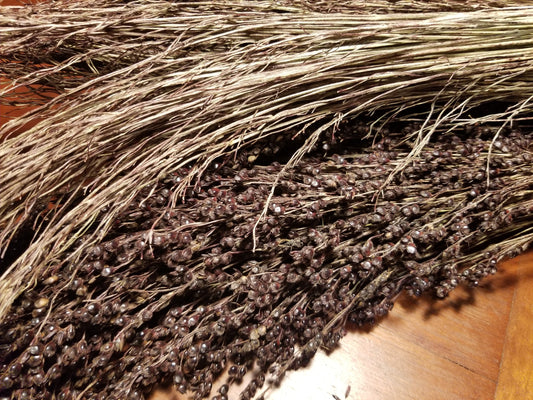Collection: Our Broomcorn Sorghum Cultivars
As its name implies, Broomcorn sorghum is a utility crop used to make brooms and whiskbrooms. Unlike other sorghums, its panicles consist of long fibrous seed branches that can reach 36 inches in length.
Broomcorn as a utility crop for brooms and whisks began as early as the Dark Ages. The Alternative Field Crops Manual Broomcorn page is an interesting discussion of its history and harvest:
"Broomcorn brush turns from pale yellow to light green before maturity. It should be harvested when the entire brush is green from the tip down to the base of the peduncle. The fibers will be weak at the bottom if they are harvested while the lower ends are still yellow. The brush often begins to redden and become less flexible about 4 or 5 days after the proper stage for harvesting.
Tall standard broomcorn is "tabled" to allow some drying before it is removed from the field. The tabler walks backward between two rows and breaks the stalks diagonally across each other to form a "table" out of the two rows that is 2 to 3 ft high. The brush is then cut, pulled out of the boot, or leaf sheath, and placed on the "table" to dry for a short time (less than 24 hours). The brush is transferred to a curing shed.
The heads of dwarf varieties are jerked or pulled from the stalks and allowed to dry for a day in bunches on the ground or between the stalks before they are hauled from the field.
Broomcorn may be threshed either before or after curing. However, threshing before curing results in better quality brush because the fine branches are less likely to be knocked off when the brush is still moist and flexible."
Be sure to check our Digital Resources Collection for informative pdfs on broomcorn.
Tillers International offers classes on making Appalachian Brooms from broomcorn sorghum. I made these various brooms during the 2 day course.

Instructor Morgan Pell provided the students this anatomy of a broom artwork so we can use the proper terminology when describing our broomcorn varieties.

 Sold out
Sold out Sold out
Sold out


